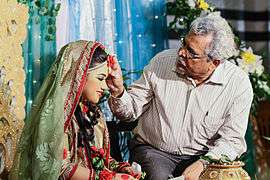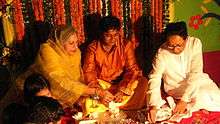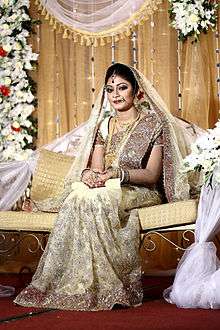Bengali wedding
A Bengali wedding (Bengali: বিয়ে, বিবাহ) includes many rituals and ceremonies that can span several days. In most cases, it starts with the Kabin ceremony (the official registration of the wedding and presenting Denmohor or Mahr) and ends with the Bou Bhat ceremony (the wedding reception, a day after the marriage, usually arranged by the groom's family). Though the rituals differ with the various districts of Bengal, among Hindus, it is usually classified into two: the Ghoti and Bangal rituals.[1][2]
Arranging the wedding
A traditional wedding is arranged by Ghotoks (matchmakers), who are generally friends or relatives of the couple, or sometimes just professional matchmakers. The Ghotoks facilitate the couple's introduction to the wedding guests, and are given special gifts called Ghotokbidae (lit., "bidding goodbye to the Ghotoks") if the alliance is agreed upon and the marriage is realized. Families traditionally seek their children's matches from the same caste, religion and social standing. In the case of an arranged marriage, if the aforementioned 'compatibility' factors are duly matched, only then is the pairing deemed a raj-jotak (an ideal match). Nowadays (as arranged marriages are not mandatory), couples often choose their life partners themselves after a period of courtship and understanding each other well, while still giving some consideration to the traditional 'compatibility' factors, however not strictly conforming to conventional notions of both partners being an "ideal match." In modern English parlance, such a non-Ghotok-arranged alliance is called a "love match" and is based more upon the preferences and wishes of the partners than strict traditional norms.
Once the arrangement is done, the planning of the wedding itself is done by parents. They usually start the planning the wedding venue many months ahead. The bride usually participates actively in shopping for her bridal attire and gifts.
Paka-dekha or Patri-Patro dekha
Although nowadays the couple find each other according to their own choices, the official engagement must follow from formal consent given by the family elders from both sides.
Through a ceremony called 'paka-dekha' (in case of Ghotis) or patri-patro, usually observed by Bangals, the alliance is formalized so final wedding preparations can proceed in due course with confidence that it is indeed intentional and assured to take place. Paka-dekha is celebrated on a day when both families convene at either side's home to fix the final date and time of day (the lagno) of the marriage, and entertain any demands made by the groom's family in order to ensure that the bride's future is well assured. Sometimes priests may also officiate, documenting the marriage's specifications for legal/government purposes, and setting the details on paper (or in current-day digital form) and signing it from both sides' present eldest guardians. Videography or static photography can be used to record the details for posterity in lieu of paper documentation.
After the legal formalities, it's time for all to enjoy the sweet rasgullas and 'misti-doi' (yogurt), treats generally catered by the groom's side.
Following the paka-dekha, public announcements of "the auspicious alliance" are made in the localities of both sides. Each such announcement is preceded by trumpeting a conch shell (blowing it like a bugle, or a similar type of heralding instrument such as a bugle is sounded, and ululations (called ululudhvanis) are made aloud by the elder married women present. The time frame within which such banns of marriage type announcements are made is typically six to eighteen months before the wedding, but in any case no later than the wedding day if possible. Hence one way casual observers realize a Bengal wedding reception is in progress is this unique vocalization made by women in attendance.
Turmeric ceremony


It begins with the Nandi mukh ceremony, when a priest, a pandit, or sometimes simply the eldest male family member or their proxy pays tribute to the deceased ancestors of both sides' parents' fathers through an elaborate pooja ritual, requesting their holy spirits to bless the couple to-be. Nandi mukh is a prayer whereby the extended family takes the blessings of the forefathers who have died. This ritual is followed by the turmeric ceremonies or gaye holud (Bengali: গায়ে হলুদ gaee holud, lit. "yellowing the body") take place before the wedding ceremony. There is one turmeric ceremony for the bride and another for the groom. For the bride's gaye holud, the groom's family - except the groom himself - travel in procession to the bride's home. They carry with them the bride's wedding dress/outfit, some wedding decorations including turmeric paste (that has lightly touched the groom's body), candy/sweetmeats and gifts. They also take a large Rohu fish decorated as a bride. After the two 'yellowing ceremonies,' the bride and groom are bathed in the water that the women had fetched from the waterway (the river Ganga, if possible) early that morning. There are local variations on this tradition, such as providing a specific number of fish to the party responsible for cooking them, and hence the best time to deliver the fresh fish to the groom's family.
The procession traditionally centers on the female relative and friends of bride, and the paste is prepared by five married women called 'Eyo-stree,' and they are traditionally all wear matching clothes, usually orange in colour. The bride is seated on a sheel-nora, and the women walk encircling her, showering Ganga (or other local waterway) water drops upon the bride.
The turmeric paste is applied to the bride's skin by her friends. This is said to soften the skin, but it also colours her in the distinctive yellow hue that gives its name to this ceremony. The sweets are then fed to the bride by all involved, one at a time. There is, of course, a feast for the guests. Married women present may also stain each other with turmeric paste.
Wedding ceremony
The wedding ceremony (Bengali: বিবাহ or বিয়ে bibaho/bie) follows the Gaye Holud(lit., "turmeric is applied to the skin") ceremonies. The wedding ceremony is arranged by the bride's family. The groom, along with his friends and family (Borjatri), traditionally arrive later in the evening.
The groom is sent a car from the bride's side and he rides inside it with two elder male relatives, one from the bride's side and another from his own family (called his Borkorta), as well as the youngest male member from his family dressed as a groom, (called his Neet bor similar to the "best man" in western traditions). Before leaving for the wedding venue, the groom is blessed by his mother and he formally seeks her permission to begin a new life with his soon-to-be "better half." The groom's mother traditionally does not attend the wedding, as that was believed to negatively impact her son's married life. Instead, she awaits at home with some other ladies for her son and daughter-in-law ('Bouma'). When the groom arrives, the bride's elder female relatives welcome him with the auspicious sound of conch-shells and ululation. Then the bride's mother ceremonially washes the wheels of the groom's car with Ganga water, feeds him sweets and admires him through the 'Bor-boron' ceremony.
The bride's family then gifts the groom with the wedding attire, which includes a 'jore' (silk shawl), 'dhoti' and 'topor', a headdress made of pith and zari. The groom must wear these items for the duration of the wedding rituals. It is also noteworthy that the wood required for the wedding yajna is brought by the groom's family, signifying the former's authoritative role over the entire ritual.

There are purohits from both families and the wedding is conducted in the form of dialogue between them using Sanskrit mantras. While the groom participates in the main wedding ritual from the outset, the bride joins it much later after she arrives accompanied by her brothers (if any) and friends, who are seated on a wooden seat called 'piri' for the ceremony. This ritual symbolizes the medieval ideas of considering a daughter as a burden for the family, although nowadays it is merely practised as a formality, and daughters are afforded affections equal to that given sons.
This is followed by the Saat paak, in which the bride encircles the groom seven times, as he remains seated on the 'piri' while covering her face with betel leaves.
Next comes the Shubhodrishti, when the bride finally removes the leaves from her face and their eyes meet. This ritual is accompanied by ululation and blowing of conch shells. The wedding is presided over by the bride's eldest male relative, who performs the Kanya sampradaan (Bengali[->5]: কন্যাসম্প্রদান konnasomprodan[->6] lit. "giving the bride").
Finally comes the Sindurdaan, when the groom covers the bride's forehead (maang) with sindoor. It is then that they are considered socially married and one.
After putting the sindoor, the bride's forehead is covered by a saree, called the 'lojja bostro,' which is gifted by the groom himself.
The 'mala boldol' or exchanging of garlands gives the wedding (seven times encircling the yajna fire or Agni dev, the Fire God). The loose ends of the bride and groom's dresses are tied in a knot called 'jor bandha' or 'gat bandhan,' and this is done by the groom's sister, whilst the bride's brother assists the couple in offering anjali of 'khoi' to the Fire God. Next, a grand feast called 'Preetibhoj' ensues in which all guests present partake. After all the preceding rituals are complete, the couple sits side-by-side and cannot open the knot by which they have been tied together. Then follows the bashorghor, which is an informal and friendly interaction between younger relatives and friends from both sides, and it continues throughout the night (akin to the western "wedding reception"). The elders usually refrain from attending this event. Basor Raat starts after midnight if the wedding ceremony is over by evening. Most Hindu Bengali marriage events are held in the evening.

The next morning (preferably before noon), the couple make their way from the wedding venue to the groom's home for the Ghotis, though for Bangals, a "Bashi Biya" or "Chaturtha-mangal" is held, and the couple leaves for the groom's house after evening. This is known as the vidaai ceremony, and the bride makes an offering of rice called "Kanakanjali" to her mother, thereby clearing any and all debts that she had incurred during her years at her paternal home—although "Kanakanjali" is not done in every Bengali marriage. While it symbolizes the end of celebrations for the bride's family, it marks the beginning of the second phase of celebrations to be organized by the groom's family. On reaching home, the couple is welcomed by the groom's mother and all other members, in a ritual called 'Bouboron'. Then the elders make gifts of gold to the bride. The bride is then asked to walk with her feet dipped in Alta on a sari, and her footprints are regarded as those of Lakshmi entering the groom's house. She is then shown the kitchen, store-room and all other things signifying prosperity, wealth and happiness of her new family. This day is also known as "Kaalratri," and on it the bride and groom are not allowed to even see each other, as Kaalratri was the very night when Behula's husband was bitten by a serpent, as stated in the Manasamangal Kavya.
After "Kaalratri", when the bride is greeted by the groom in the morning of "Bou Bhaat", a ritual called "Bhaat Kapor" is initiated by the groom where he gifts the bride with essential accessories of a married woman, sari and other auspicious things on a plate of silver (these items are given by husband only and not by in-laws of bride); nowadays they also use other metals like brass etc. This signifies that the groom would hence be taking care of all the needs and requirements of his bride from that day onwards; this also signifies the domination of the male individual in the old vedic society. After receiving all these items from her husband, the bride takes blessing from her husband and hence begins the rituals of "Bou Bhaat".
Bou Bhaat
The following day, i.e., the second day of the bride at her new home is celebrated as Bou Bhaat as on this day, she serves Rice with Ghee to all her in-laws at lunch. The evening is celebrated as a reception party, where all the distant relatives along with the close ones from the groom's side are invited and introduced to the bride. The bride's family members 'Konyajatri' also attend the reception with 'tatwo'(gtifts of clothes, sweetmeats, jewellery, and all other essentials for the bride and her in-laws). A grand feast is carried out called 'Preetibhoj'- It is a gala dinner to introduce the Bride to the society and the whole of the family. In the old days the dinner was all prepared by the family themselves. Sweet was made at home by 'Vien'. Friends and neighbors used to volunteer to distribute the food, which was usually done on banana leaves. But now the Catering Service has taken over the whole initiative.
Phul Shojja

In the flower bed ceremony (Bengali: ফুল শয্যা ful shôjja, lit. "flower bed"), the bride wears a lot of floral ornaments presented by the bride's family, and their marriage bed is decorated with flowers by the groom's family. This is the night of consummation.
Oshto Mongola
Eight days after marriage, the couple visits the bride's house and spends three nights there. It is accompanied by relentless feasting, and opening of the 'Gatbandhan' that had been tied on their day of marriage.
Among the Bengali Hindus of Sylheti origin, this ritual is known as "Fira-jatra".
Shubhochuni Satyanarayan Puja
On the eighth day of marriage, a Satyanarayan puja is conducted by the groom's family, in which the newly wed couple, in their wedding attires, are blessed by the purohit and prayers are offered to bless the couple with a happy family. The couple then leaves for Oshtomongola.
Photo Gallery
-

Bride and Bridegroom are sitting in a wedding stage.
-

A Bangladeshi bride
-

Hand of Bride in the Turmeric ceremony
-

Three varieties of pithas decorated to be sent as a gift to the bride's house in Gaye Holud ceremony
-
The bridegroom signing the document of marriage
See also
References
- ↑ "Bengali Wedding Rituals - A Traditional Bengali Marriage Ceremony". hinduism.about.com. Retrieved 2008-11-21.
- ↑ "Weddings In India - Wedding in Exotic Indian Locations". www.weddingsinindia.com. Retrieved 2008-11-21.